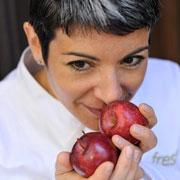Even though temperatures on Friday nearly reached 60 degrees, sustained warmth is still many weeks away. Tubers from one type of sunflower—sunchokes—can be found at farmers' markets and grocery stores and are a welcome addition to standard winter root vegetables like potatoes and carrots.
“[The sunchoke] is in the sunflower family,” explains farmer Lee Jones, who grows two different kinds of sunchokes for The Chef’s Garden in Huron, Ohio. “In fact, your listeners might have seen them growing along the roads...It looks like a small sunflower blossom, and they grow pretty prolifically.”
Chef Erica Wides, also known as Chef Smarty Pants and a regular guest on Last Chance Foods, is a sunchoke fan. Though Wides says she never ate them as a child because they looked so strange, her father grew sunchokes in her family’s garden on Long Island. “Sort of looks like a potato and a ginger root got together and had a baby,” she explains. “Inside, they have this nice crispy, kind of creamy beige flesh, a lot like jicama.”
For those unfamiliar with sunchokes, they’re also often referred to by the misnomer “Jerusalem artichokes.” In reality, they are neither from Jerusalem nor related to artichokes. Native to North America, Italian settlers call the sunchoke a “girosol,” which is Italian for sunflower. Over time, girosol became “Jerusalem.” Sunchokes became associated with artichokes after the French explorer Samuel de Champlain described the two as tasting similar. 
“They’re so easy to grow that they’re considered a weed by a lot of gardeners, like a scourge, like they’ll take over,” says Wides. “And if you don’t want them anymore, you have to completely dig them up, because if you leave a little piece behind, it’ll grow all over again.”
Sunchokes remain under the radar in the United States for a number of reasons. There was a period of time when people believed eating them caused leprosy, because the root vegetable looks like a leper’s finger. Wides adds that sunchokes, along with rutabagas, were among the most widely available vegetables during World War II. “I think that it was really kind of looked like as more of a layman's or a poor man’s vegetable that really sort of got pushed to the side,” says Jones. “It was an American Indian vegetable, and I think it was one of those crops that, like many in the United States, got lost.”
One downside to sunchokes is that many people have a hard time breaking down a carbohydrate called inulin that’s found in the vegetable. This can often lead to gastric distress. But it can be good for diabetics, since the inulin in sunchokes is broken down into fructose, instead of glucose.
Wides, who happily eats sunchokes without any ill side effects, has shared her recipe for making soup out of sunchokes. Try it out below.
Sunchoke Veloute
by Erica Wides
- 2 Tbsp good olive oil
- 1 garlic clove, peeled and crushed
- 1/2 cup chopped onion
- 1 pound Jerusalem artichokes (washed, un-peeled, sliced 1/4-inch thick)
- 2 cups chicken stock
- 1/2 cup cream, half and half or milk
- salt and white pepper
- 1 teaspoon chopped chives for garnish
1. Heat the oil in a medium-size saucepan over medium heat, add the garlic and onion and cook until soft, about two minutes.
2. Add the Jerusalem artichokes and gently sauté about two minutes.
3. Add the stock and bring to a low boil. Lower the heat and simmer until the chokes are tender.
4. Add the cream and bring back to a low boil. Season with salt and pepper.
5. Strain the soup solids into a blender, reserving the liquid, and add the liquid to the blender gradually, while blending, until the desired consistency is attained.
6. Strain the soup through a fine sieve to remove the peels and fiber. Keep the soup warm until service, adjust the seasoning and serve sprinkled with the chives.